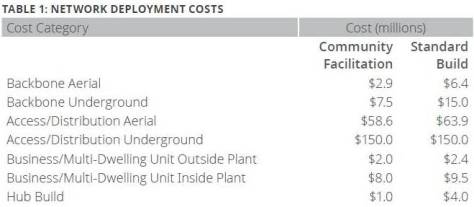 Communities that want to entice communications network operators to construct ultra-high speed networks can reduce deployment costs by as much as 8% by adopting the right policies, says a new report from CTC Technology & Energy.
Communities that want to entice communications network operators to construct ultra-high speed networks can reduce deployment costs by as much as 8% by adopting the right policies, says a new report from CTC Technology & Energy.
The report, titled “Gigabit Communities: Technical Strategies for Facilitating Public or Private Broadband Construction in Your Community,” was funded by Google but CTC said it maintained full editorial control.
CTC President and co-author of the report Joanne Hovis is a broadband consultant who has closely studied telecom policy issues.
Key CTC recommendations for communities include:
- Providing access to any fiber assets the community may have
- Providing locations for hub facilities where a new broadband provider can locate equipment
- Requiring owners and developers of multi-dwelling units and multi-tenant office buildings to construct conduit for broadband providers from the right-of-way to the building as part of construction or renovation
- Requiring owners and developers of multi- dwelling units and multi-tenant office buildings to construct indoor cable pathways for broadband providers from the right-of-way to the apartment or business as part of construction or renovation
- Working with management of the companies that own utility poles (usually investor-owned utility and an incumbent phone company) to facilitate attachment by new entrants
- The report authors cite the hypothetical example of a community of 250,000 homes and businesses of which 20,000 are located in 500 large multi-dwelling buildings. The example also assumes that the recommended requirements have been in place for a few years.
According to CTC’s estimate, network construction costs would be just $230 million, compared to $251 million without community facilitation.

Other policies that the authors advise communities to consider are:
- Facilitate underground construction by developing “dig once” policies that advise other stakeholders whenever another stakeholder digs trenches
- Publish data about available conduit, existing utilities and other assets, preferably using a geographic information system
- Streamline permitting by, for example, allowing network operators to use third-party inspectors
- Facilitate aerial construction by working with pole owners to clear space and secure access for new entrants. For example, communities could require anyone installing poles to reserve a space of 12 to 16 inches for future attachments. “In our experience eliminating the time and costs around make-ready can reduce the average cost of aerial fiber construction from $10 to $15 per foot to $2 to $5 per foot,” the authors write.
CTC is the latest of several organizations that have explored what communities can do to reduce the cost of deploying gigabit networks. Others that have studied the issue and come up with some good ideas include the Pew Center on the States, Gig.U and Gigabit Squared.
Google has gained considerable expertise in working with communities to reduce the cost of deploying gigabit networks and other network operators have begun to ask communities to work with them in a similar manner — particularly if Google is already involved in the community.
